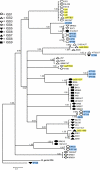MLST of housekeeping genes captures geographic population structure and suggests a European origin of Borrelia burgdorferi
- PMID: 18574151
- PMCID: PMC2435589
- DOI: 10.1073/pnas.0800323105
MLST of housekeeping genes captures geographic population structure and suggests a European origin of Borrelia burgdorferi
Abstract
Lyme borreliosis, caused by the tick-borne bacterium Borrelia burgdorferi, has become the most common vector-borne disease in North America over the last three decades. To understand the dynamics of the epizootic spread and to predict the evolutionary trajectories of B. burgdorferi, accurate information on the population structure and the evolutionary relationships of the pathogen is crucial. We, therefore, developed a multilocus sequence typing (MLST) scheme for B. burgdorferi based on eight chromosomal housekeeping genes. We validated the MLST scheme on B. burgdorferi specimens from North America and Europe, comprising both cultured isolates and infected ticks. These data were compared with sequences for the commonly used genetic markers rrs-rrlA intergenic spacer (IGS) and the gene encoding the outer surface protein C (ospC). The study demonstrates that the concatenated sequences of the housekeeping genes of B. burgdorferi provide highly resolved phylogenetic signals and that the housekeeping genes evolve differently compared with the IGS locus and ospC. Using sequence data, the study reveals that North American and European populations of B. burgdorferi correspond to genetically distinct populations. Importantly, the MLST data suggest that B. burgdorferi originated in Europe rather than in North America as proposed previously.
Conflict of interest statement
The authors declare no conflict of interest.
Figures



References
-
- Burgdorfer W, et al. Lyme disease—a tick-borne spirochetosis? Science. 1982;216:1317–1319. - PubMed
-
- Kurtenbach K, et al. Fundamental processes in the evolutionary ecology of Lyme borreliosis. Nat Rev Microbiol. 2006;4:660–669. - PubMed
-
- Kurtenbach K, Schaefer SM, de Michelis S, Etti S, Sewell HS. In: Lyme Borreliosis: Biology of the Infectious Agents and Epidemiology of Disease. Gray JS, Kahl O, Lane RS, Stanek G, editors. Wallingford, UK: CABI; 2002. pp. 117–148.
-
- Piesman J, Gern L. Lyme borreliosis in Europe and North America. Parasitology. 2004;129(Suppl):S191–S220. - PubMed
Publication types
MeSH terms
Substances
Associated data
- Actions
- Actions
- Actions
- Actions
- Actions
- Actions
- Actions
- Actions
- Actions
- Actions
- Actions
- Actions
- Actions
- Actions
- Actions
- Actions
- Actions
- Actions
- Actions
- Actions
- Actions
- Actions
- Actions
- Actions
- Actions
- Actions
- Actions
- Actions
- Actions
- Actions
- Actions
- Actions
- Actions
- Actions
- Actions
- Actions
- Actions
- Actions
- Actions
- Actions
- Actions
- Actions
- Actions
- Actions
- Actions
- Actions
- Actions
- Actions
- Actions
- Actions
- Actions
- Actions
- Actions
- Actions
- Actions
- Actions
- Actions
- Actions
- Actions
- Actions
- Actions
- Actions
- Actions
- Actions
- Actions
- Actions
- Actions
- Actions
- Actions
- Actions
- Actions
- Actions
- Actions
- Actions
- Actions
- Actions
- Actions
- Actions
- Actions
- Actions
- Actions
- Actions
- Actions
- Actions
- Actions
- Actions
- Actions
- Actions
- Actions
- Actions
- Actions
- Actions
- Actions
- Actions
- Actions
- Actions
- Actions
- Actions
- Actions
- Actions
Grants and funding
LinkOut - more resources
Full Text Sources
Other Literature Sources

